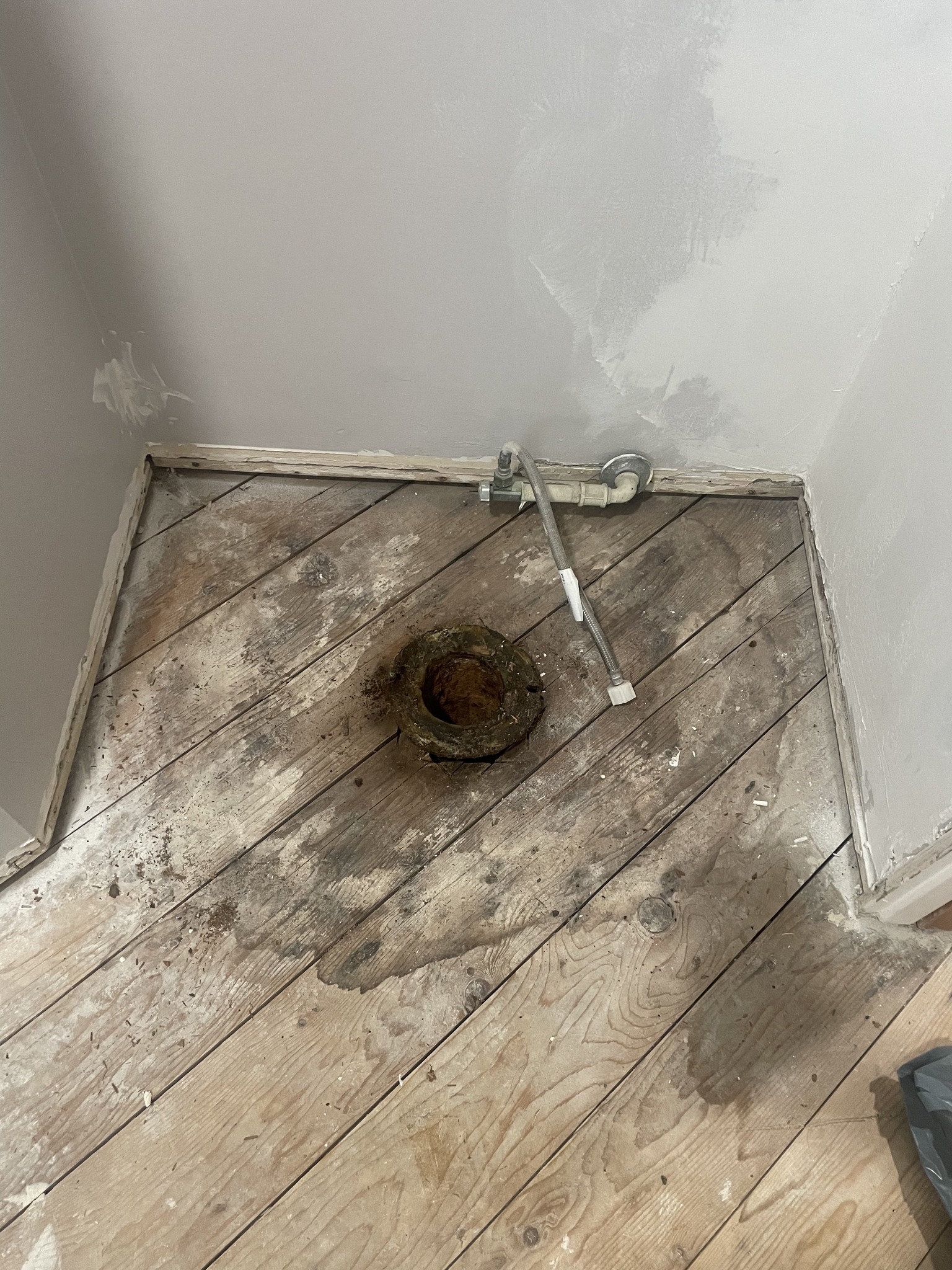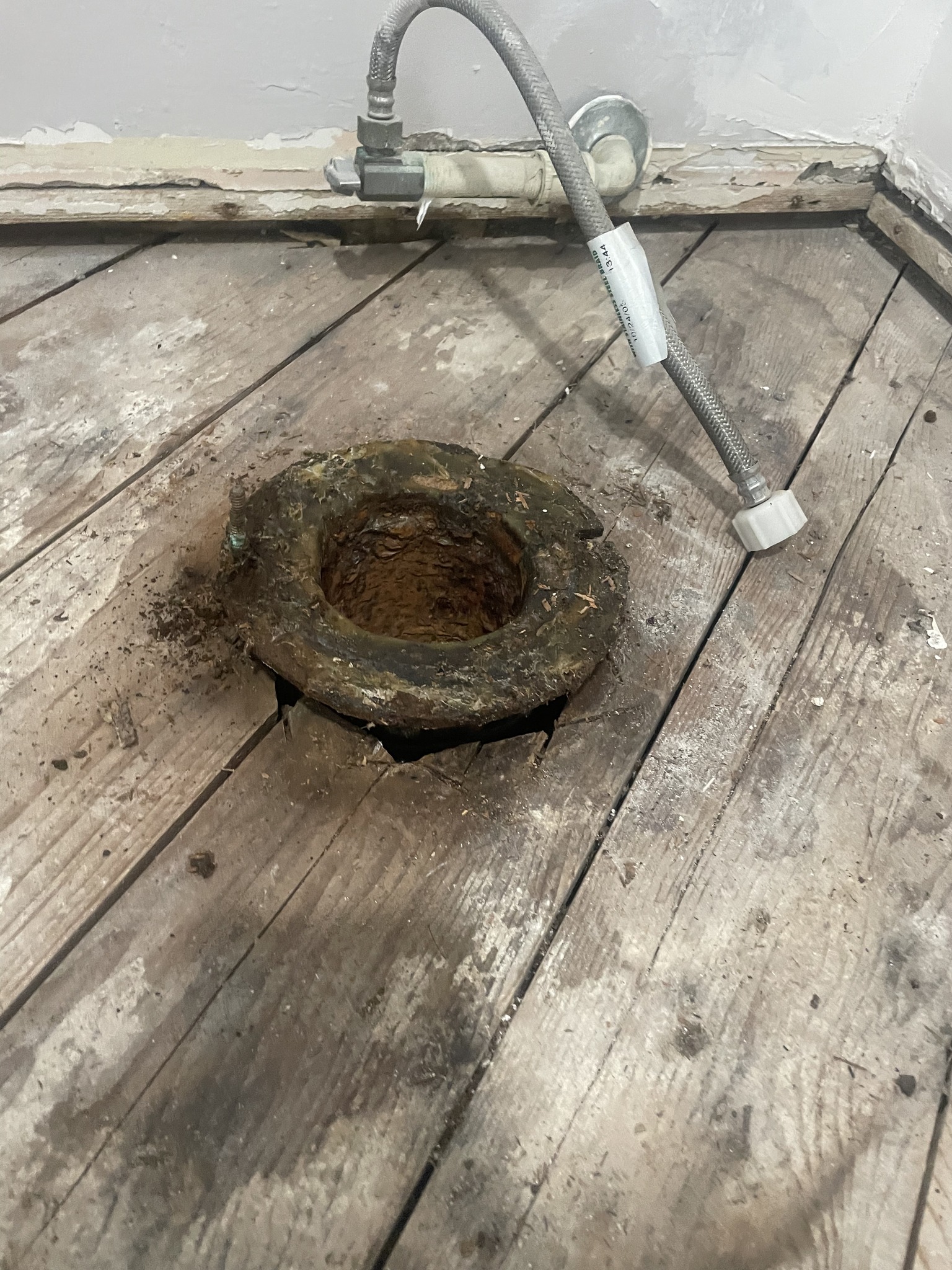How can I safely remove a cast iron toilet flange secured at the pipe in a house built in 1959 without damaging anything?
8 months ago
Last Updated: October 12, 2024
Hey there, I’m a bit of a newbie at this so please bear with me. I’m trying to install cement board on the floor, but I’m stuck on removing this pesky toilet flange. It seems to be made of some tough material like cast iron and is definitely not budging with just removing screws. Any ideas on how to tackle this? Should I go ahead and use a saw to cut it off at the pipe? Any advice would be greatly appreciated!


Oh man, gotta appreciate old houses! Mine is 44 years old and the things I uncover are unreal. You might want to consider bringing in a professional plumber to take a look.
I’m a bit puzzled too. Aren’t you planning to put the toilet back in place? Are you intending to lay cement board directly over the exposed flange/pipe?
Check out the flange repair kits at Home Depot…they can be a lifesaver!
Remove the lead by drilling it out and detach it from the pipe
If you don’t, you’ll encounter issues.
No worries about taking it out. Just clean the wax off. It appears to be made of cast iron. It might not be as simple as you’d like. If necessary, you can attach a new flange over it – typically just a red painted ring, no protrusion, just a flat surface.
I just wrapped up a job like that. Let me tell you, I’ve done some crazy things like using a trolley jack to move half a house for an addition, quickly replacing a gas shut-off valve downstream of the meter due to rust, and even fixing a damper in a chimney while my friend passed me tools with a fishing rod. But when it comes to cast iron toilet flanges, I leave that to my trusted plumber. Dealing with a faulty flange is a mess, and the cast iron below the floor is both durable and delicate at the same time.
It’s a good thing we took photos before starting the work. The cast elbow has been replaced with fresh PVC and the subfloor is brand new. The leak was coming from the lead repair sleeve at the flange, through the carriage bolt holes used to secure the flange to the poorly patched floor, and a small rip at the elbow most likely from overtightening the toilet. Plumbers definitely earn their money!
No problem. Use a reciprocating saw to cut it off at floor level, then you can put in a new PVC or metal one later on
I’d keep it and slide your board underneath. If you choose to change it, consider hiring a plumber
You don’t have to take it out, just lay your cement board around it
Scrape off the wax and investigate what material is present. If it’s lead, you can likely locate a toilet flange with a rubber boot that fits snugly inside. You might need to trim a section of that flange to align it with the floor level, though.
Why are you taking off the flange? Is it broken? Are you moving or getting rid of the toilet?
Hey Al, one of the sites where the bolt holds in place has rusted away. Also, I took the measurements and realized that after a 1/4″ cement board and the tile I plan to install, the flange won’t sit on top of the tile as recommended.
We actually have these nifty things called flange extenders! We had to use them to lift up our flange a bit for the hardwood.
Has a common name, so that’s why they offer extensions.
First, grind the surface and then use a cold chisel to break it with a hammer. Pull it off, remove the old rope and lead, clean it up, and proceed to install your new floor. You can choose to install a new one or use a PVC with a runner bushing that fits inside the existing pipe!
Oh wow, I totally saw a plumber on Reels doing exactly that. And he was quick!
Absolutely! I’ve used them several times and they work wonders, you just need to be familiar with your tools. Some people are intimidated by tools and believe they can be too harsh, but when used correctly, you can accomplish anything!
You should start by adding plywood to raise the floor to the level of the flange. After that, you can tile over it up to the raised flange.
You shouldn’t tile over plywood.
You’re right, … It really depends on whether the floor is upstairs or not.
If you cut away some of the subfloor near the flange, you’ll open up more possibilities, unless it’s already visible from below. I’ve used abrasive blades on a sawzall and grinder wheels to slice through cast iron. If you can reach it from beneath, that would be simpler than taking out the subfloor (although you might want to replace the subfloor regardless to ensure a sturdy surface for mounting the flange). Either way, I’d recommend cutting it in a strategic location so you can switch it to PVC with a fernco. That way, you can install new PVC and a flange wherever necessary.
When cutting the cement board around it, make sure the bottom of the flange matches the height of the top of the tile.
I’m actually the one who does this type of work. I go into the crawl space, cut the cast, raise it 4 inches, then secure it to the floor. I shim the flange and glue it so it sits on top of the tile when it’s done.
I recall seeing this episode again last month! He’s amazing. Check it out: https://youtu.be/PnXezZt6OMk
Start by removing the wax ring. Then lower the cement board by cutting out the section around the flange. Remember, you’re working on the flooring, not the plumbing.
Check this out!
https://youtu.be/wKI3NC674MA?si=17ikOuunHIKupxXS
Our previous house was also old and we faced a similar issue. There’s a kit available for purchase that can stick to the pipe. It will reduce the size of the opening, so make sure to measure accurately. It’s been a while, so the specifics are a bit hazy. We cut it level with the floor and then applied the kit.
Try drilling it out or cutting it off. It’s not a quick job.
Check all of your cast iron soil pipes regularly. They tend to corrode after around 50 years.
It’s best to hire a professional as it’s not a simple job.
Trim around the area. Install an extension with a high-quality wax ring if necessary. Leave it alone.
The subfloor must be removed if you can’t access it from below.
Why not just work around the toilet flange and use a double wax ring when installing the floor?
I’m really impressed by the variety of answers, but it seems like most people are not sure. Two correct ways to tackle this are: 1) removing the flange with a cold chisel (may require some effort but not too difficult), and 2) cutting the concrete board in half and sliding it under the flange.
Do you have to take it out? Is it damaged? Are you installing a toilet there? Then adjust the cement boards around the flange, like notching two boards on the edges and fitting them together, or cutting one board in half. However you decide to handle it. Just be careful not to cut it unless you want to make more work for yourself later on if the bathroom is staying a bathroom. And it’s soldered with lead, so if you don’t know how to unsolder a lead joint, best to leave it be.
You should also consider checking out Ask A Plumber.
To start, you need to remove the wax from the flange. Then cook for 10 minutes, flipping halfway. Let it rest for 10 minutes. Serve with a side of t-bolts. Just kidding. Definitely hire a plumber. To replace the flange, you’ll need to cut the piping below.
No disrespect intended, but my suggestion would be to contact a plumber. There are a few things to consider. If you’re set on doing it yourself, feel free to send me a private message and we can FaceTime while working on it (I’m a contractor). It’s not overly complicated, but there’s a lot to explain in one message.